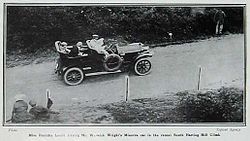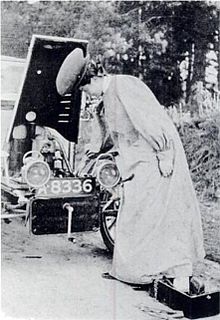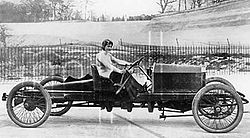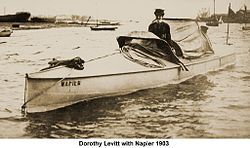- Dorothy Levitt
-
Dorothy Levitt 
Dorothy Levitt on the frontispiece of
The Woman and the CarBorn 1883[1]
Probably Hackney LondonDied Probably 18 May 1922. Age c. 40
Possibly 50 Upper Baker Street, Marylebone, LondonNationality British Other names The fastest girl on Earth Occupation Sporting Motoriste, Journalist, Known for 1903 – First woman to compete in a 'motor race'.
1905 - record for the longest drive achieved by a lady driver from London to Liverpool and back.
1906 Ladies World Land Speed record holderDorothy Elizabeth Levitt,[2] (probably born Dorothy Elizabeth Levi[2], c. 1882, probably died 18 May 1922) was a motorina and sporting motoriste of the early 20th century. On 4 July 1903 she was reported as the first woman ever to compete in a motor race. Levitt was a renowned pioneer of female independence, female motoring, motor racing, the most successful female competitor in Great Britain, victorious speedboat driver, holder of the Ladies World Land speed record,[3][4][5] motoring writer, journalist and activist. In 1905 she established the record for the longest drive achieved by a lady driver by driving a De Dion-Bouton from London to Liverpool and back. In 1906 she broke the women's world speed record in a speed trial in Blackpool, and was described as "the fastest girl on Earth".[3]
Her book The Woman and the Car: A chatty little handbook for all women who motor or who want to motor, noted that women should "carry a little hand-mirror in a convenient place when driving" so they may "hold the mirror aloft from time to time in order to see behind while driving in traffic", thus inventing the rear view mirror before it was introduced by manufacturers in 1914.[6]
Contents
Early life
Dorothy's family origins are uncertain; she was probably born Dorothy Elizabeth Levi,[2] or possibly Elizabeth Levi,[7] Elizabeth Levit,[8] or Dorothy Elizabeth Levitt.[2] She was probably born in Hackney in 1882 as a Sephardi Jew.[1]
Dorothy was probably the daughter of Jacob Levi, a Jewish tea dealer or a Commission Agent of Colvestone Crescent, Hackney, who, according to the 1891 census, was born in Aldgate, London in about 1851. Jacob had apparently anglicised his name to John Levit by the 1901 census.[7][2][9][10][11] Dorothy's mother was probably born Julia Raphael in Aldgate 31 Oct 1856 (or possibly 1858), married Jacob Levi in the Seyds Hotel Finsbury in March 1877 and died in 1942.[2][9][12][10][11][1]
Her paternal grandparents were probably Leman (Lemon) Levi (b.Portsmouth 1804 - d.1895) a Jeweller of 18 Colvestone Crescent, Hackney, London, who married Elizabeth Meyers (1816-1893) in the Great Synagogue Whitechapel in 1833. They had 10 children including Dorothy's father Jacob (who also used the name Jack & John). Dorothy's maternal grandparents were Joseph Raphael (b.1807 Portsmouth, d.7 Nov 1893, London), and Elizabeth Sewill (b.1818 in Liverpool, d.1897 in London).[1]
Dorothy probably had two sisters, Lilly, (b.6 March 1878, London, d.8 April 1879); and Elsie Ruby Levi/Levitt, who was born in 1892 in Islington, married Mark Solomon Clarence Lewis in Willesden in 1917, and died in Brighton in 1959 (or 1963).[2][10][11][1]
Before her recognition for motoring Levitt was reportedly a noted horse-rider.[13] Everywoman's Encyclopedia reports that S.F. Edge, the owner of Napier Cars, advised her to enter the automobile profession, and after six months she understood the mechanism of a car.[14] Dorothy was originally employed as a secretary at the Napier & Son works in Vine Street Lambeth.[15][16]
In 1913 Dorothy was living at Portman Mansions, Chiltern Street, in Marylebone (according to the telephone directory).
Pioneer feminist and female motorist
In the book The car and British society: class, gender and motoring, 1896-1939, Sean O'Connell described Levitt as 'arguably the best known of the early women drivers' in an age when male prejudices against women drivers were typified by a 1905 item in Autocar which opined the hope that 'the controlling of motor cars will be wrested from the hands of ... these would be men'. Thus the preface to the first edition of her book The Woman and the Car: A chatty little handbook for all women who motor or who want to motor, stated that :
She was described as 'slight in nature, shy and shrinking, almost timid. Her book went on to state that [there might] be pleasure in being whisked around the country by your friends and relatives, or ... chauffeur, but the real intense pleasure only comes when you drive your own car.[13]
Both Levitt's book and newspaper column in The Graphic described her atypical lifestyle for the Edwardian era, an independent, privileged, 'bachelor girl', living with friends in the 'West End' of London and waited on by two servants.[17][13]
Sporting motoring
Selwyn Edge, Director of the Napier Car Company and famous racing driver ... spotted Miss Dorothy Levitt amongst his staff, a beautiful secretary with long legs and eyes like pools. In a bid to promote his cars ... Edge decided that she should take part in a race, though first he had to teach her to drive. She surpassed his expectations by winning her class in the 1903 Southport Speed Trial, and proved such a good driver that she was taken on by De Dion for a major publicity stunt. At the Hereford Thousand Miles Trial in 1904, Dorothy posed before members of the press, delighted by her uncommonly glamorous racing outfit, holding a snappy Pomeranian dog that barked ferociously at all the other competitors – who got their own back the following day by sporting hideous toy dogs attached to the bonnets during the racesOn 4 July 1903 Dorothy Levitt won her class at the Southport Speed Trials driving a S.F.Edge's 12 hp Gladiator,[18] shocking British society as she was the first woman, a working secretary, to compete in a motor race. She became noted for racing in a dust coat (a loose coverall coat reaching down to the ankles),[19] matching hat and veil. On 25 July 1903 at the Sun-Rise Hill Climb near Edgehill in Warwickshire she was the official passenger of S.F. Edge because her Gladiator was a non-starter.[20] In 1903 she was reportedly the first woman driver to win an automobile race at Cowes on the Isle of Wight.[21]
In 1904 Dorothy Levitt raced an officially entered De Dion car in the Hereford 1,000-mile (1,600 km) trial. Only mechanical problems on the final day, which she repaired herself,[16] prevented her from winning a gold medal.[7]
In March 1905 Levitt established a new record for the "longest drive achieved by a lady driver". She drove a De Dion-Bouton from London to Liverpool and back in two days, without the aid of a mechanic but accompanied by an official observer, her pet Pomerainian dog Dodo, plus a revolver. At 07:00 on 29 March 1905 she departed from the De-Dion showroom in Great Marlborough Street London, and arrived at the Adelphi Hotel in Liverpool at 18:10, having completed the 205 miles in a little over 11 hours. (Liverpool was the home of her maternal grandmother.)[22][23]
In 1905 Levitt drove an 80 hp (or 100 hp) Napier at the inaugural Brighton Speed Trials, winning both her class and the Autocar Challenge Trophy. She also drove a 100 hp (74.6 kW) development of the Napier K5 at the Blackpool Speed Trials.[4][5] A works drive in a French Mors in the inaugural RAC Tourist Trophy Race on the Isle of Man had been prohibited by Selwyn Edge in order to protect the reputation of his Napier marquee. Ironically the 208-mile (335 km) 1905 event was won by Mr. J. S. Napier in his Arrol Johnson car, ahead of 40 competitors.[24][25]
At the Blackpool Speed Trial in 1906 she broke the Women's World Speed Record by recording a speed of 90.88 mph (146.26 km/h) (146.25 km/h) over a flying kilometre, driving the 100 hp (74.6 kW) development of the Napier K5-L48. She was described as "the fastest girl on Earth".[3][4][5] She also set the Ladies' Record at the Shelsley Walsh Speed Hillclimb in a 50 hp Napier (7790 cc), making the climb in 92.4 seconds, 12 seconds faster than the male winner and around three minutes faster than the previous record set by Miss Larkins and sixth fastest overall. Her record stood until 1913.
 Dorothy Levitt drives Warwick Wright and guests in his Minerva in the 1907 South Harting, West Sussex, hill climb
Dorothy Levitt drives Warwick Wright and guests in his Minerva in the 1907 South Harting, West Sussex, hill climb
In 1907 the newly opened Brooklands circuit would not accept her entry, even though she was vouchsafed by S. F. Edge, and it continued to reject women drivers until 1908. Thus she set her sights on Europe. In October she won her class in the Gaillon Hillclimb in France, driving a 40 hp 6-cylinder Napier.[20] Additionally she is reported to have finished second in the Bexhill on Sea Speed Trial along the sea front.[26]
Her 1908 schedule was hectic and successful. In June she drove a 45 hp Napier to win a silver plaque in the Prinz Heinrich Trophy at the Herkomer Trophy Trial in Germany. In July her 60 hp Napier was second fastest of over 50 competitors at the Aston Clinton Hill Climb in Buckinghamshire. In August she competed at La Cote du Calvaire hill climb at Trouville in France.[20]
She was effectively both a works driver and publicist for Napier cars, which was owned by Selwyn Edge, whose mistress she was for a time.
Motor yachting
In 1903 Dorothy Levitt won the inaugural British International Harmsworth Trophy for speedboats at Cork Harbour in Ireland. She achieved 19.3 mph (31.1 km/h) in a 40-foot (12 m) steel-hulled, Napier speedboat fitted with a 3-blade propeller, owned by Selwyn Edge. S. F. Edge was both the owner and entrant of the boat, and thus "S. F. Edge" is engraved on the trophy as the winner. The third crew member, Campbell Muir, may also have taken the controls.
Pioneering aviation
In 1909 Dorothy Levitt attempted to qualify as a pilot at the Hubert Latham School of Aviation at Châlons Camp Mourmelon-le-Grand, between Châlons-en-Champagne and Rheims in France. [27] She attended along with Marie Marvingt and Baroness Raymonde de Laroche, the only woman ever licensed in the difficult to fly Antoinette monoplane. Dorothy became a member of The Aero Club of the United Kingdom in January 1910, and was booked to give a talk at the Criterion Restaurant on Thursday, 3 March 1910 about her experiences learning to fly.[28] Nothing else is currently known.
Journalism
She became the leading exponent of a woman's "right to motor" and in 1909 published The Woman and the Car: A Chatty Little Hand Book for Women Who Motor or Want to Motor, based on her newspaper column in The Graphic. She also gave many lectures to encourage women to take up motoring.
Dorothy Levitt tried to counter the clichés about mechanically ignorant females:
I am constantly asked by some astonished people "Do you really understand all the horrid machinery of a motor, and could you mend it if it broke down? ... the details of an engine may sound complicated and look "horrid", but an engine is easily mastered.[16]Her book contained many tips, including carrying a ladies hand mirror, to "occasionally hold up to see what is behind you". Thus she can be said to have pioneered the rear view mirror seven years before it was adopted by manufacturers.
Court appearances
On 6 November 1903, she was summonsed to appear at Marlborough Street Assizes for speeding in Hyde Park. She was said to have driven at a "terrific pace" and, when stopped, apparently "said she would like to drive over every policeman and wished she had run over the sergeant and killed him". Although she did not appear personally, the magistrate, Mr Denman, fined her £5 with 2s costs. The other six motoring defendants that day were only fined £2 plus costs.[29]
In about 1903, Dorothy Levitt and her friend Hena Frankton claimed damages against a GPO van driver who had hit their car. They received compensation of £35.[29]
Pioneering Motoring
 Dorothy Levitt demonstrates how to prime the carburettor, dressed in her own design of blue "dust-coat".
Dorothy Levitt demonstrates how to prime the carburettor, dressed in her own design of blue "dust-coat".
Photograph by Horace Nichols, to accompany Dorothy's column in The Graphic and The Woman and The Car. c. 1907/9Excerpts from The Woman and the Car: A chatty little handbook for all women who motor or who want to motor by Dorothy Levitt, c. 1907.[17]
Motoring is a pastime for women; young, middle-aged and – if there are any – old. There may be pleasure in being whirled around the country by your friends and relatives, or in a car driven by your chauffeur; but the real, the intense pleasure comes only when you drive you own car.[17]
The Car – There are scores of makes, good, bad and indifferent. I tried many cars and have come to the conclusion that the De Dion is the ideal, single cylinder car for a woman to drive. The single cylinder car is the most economical to run. The horse-power is usually 8 h.p. or less. As regards carriage work, the Victoria type of body has the most graceful lines. Such a car as I have described will cost, new, from 230 pounds. The price however is for the car itself, accessories bring up the cost.[17]
Starting a Car – In the front you will notice a handle. Push it inwards until you feel it fit into a notch, then pull it sharply, releasing your hold of the handle the minute you feel you have pulled it over the resisting point. On no account press down on the handle, always pull it upwards smartly. It if is pressed down the possibility of backfire is greater – and a broken arm may result.[17][30]
Changing Speed – In changing speed always remember to throttle slightly. Never change from first to top speed without using the intermediate speed. The first speed on these little cars is 0–9 miles an hour, the second is 9–18 and the top is 18–28. I should advise you to thoroughly get used to the steering while on second speed. Bear in mind that when riding or driving a horse, it is only partly under your control, as it has a brain. With a motor-car, you are on your own.[17]
The Mirror – The mirror should be fairly large to be really useful and it is better to have one with a handle. Just before starting take the glass out of the little drawer and put it into the little flap pocket of the car. You will find it useful to have handy, not only for personal use, but to occasionally hold up to see what is behind you.[17]
Motor Manners – Pedestrians, according to the law, practically own the highways. Dogs, chickens and other domestic animals at large are not pedestrians, and if one is driving at regular speed one is not responsible for their untimely end. It is advisable to drive slowly through town and villages and especially school houses. Drive slowly past anyone driving or riding a horse and if a lady or child is on top, stop the engine. It is an act of courtesy. Do not fail to sound the hooter and slacken speed when coming to a cross road. Never take a sharp corner at full speed. Never drive the engine downhill. Do not leave the engine running when stopping outside a house.[17]
What to Wear – An all important question is dress. With an open car, neatness and comfort are essential. Under no circumstance wear lace or fluffy adjuncts to your toilet. There is nothing like a thick frieze, homespun or tweed coat lined with fur. Do not heed the cry, 'nothing like leather.' Leather coats do not wear gracefully. One of the most important articles of wear is a scarf or muffler for the neck. Regarding gloves – never wear woollen gloves, but gloves made of good soft kid. You will find room for these gloves in the little drawer under the seat of the car. It is not advisable to wear rings. Indispensable to the motorist is the 'overall,' this should be made of butcher blue linen in the same shape as an artist's overall.[17]
Death
Dorothy's life after 1910 is currently undocumented but she appears to have died, unmarried, on 17 May 1922 in Marylebone according to Probate granted to her sister Elsie on 27 Sept 1922 and death registration. She is recorded as Dorothy Elizabeth Levitt and Dorothy E Levi. Her estate was valued at £224 2s 5d (about £4,750 at 2010 valuation).[2][31]
References
- ^ a b c d e Sefardies Genealogy. Julia Raphael
- ^ a b c d e f g h England & Wales, National Probate Calendar (Index of Wills and Administrations),1861–1941 about Dorothy Elizabeth Levitt 1922
- ^ a b c Women in Motorsport – Timeline
- ^ a b c Hull, Peter G. "Napier: The Stradivarius of the Road", in Northey, Tom, ed. The World of Automobiles (London: Orbis, 1974), Volume 13, p.1483.
- ^ a b c Georgano, G.N. Cars: Early and Vintage, 1886–1930. (London: Grange-Universal, 1985).
- ^ "All female team create award-winning concept car". Volvo. Archived from the original on 2006-08-30. http://web.archive.org/web/20060830174006/http://en.volvocars.ae/footer/about/NewsEvents/News/news.htm?item=%7bE70B9AD7-1561-4D4D-9951-B79BDEEE28A1%7d. Retrieved 2006-12-14.
- ^ a b c Radnorian Blog – Addressing Motoring, culture and history of Radnorshire
- ^ 1901 census
- ^ a b 1881 Census
- ^ a b c 1901 Census
- ^ a b c 1911 Census
- ^ 1891 Census
- ^ a b c d The car and British society: class, gender and motoring, 1896-1939 By Sean O'Connell
- ^ Everywoman's Encyclopedia, Dorothy Levitt
- ^ a b Fast Ladies: Female Racing Drivers 1888 to 1970 By Jean Francois Bouzanquet
- ^ a b c Profile of Dorothy Levitt at Google Books – Women and the Machine by Julie Wosk
- ^ a b c d e f g h i j Levitt, Dorothy. The Woman and the Car. ISBN 978-0238789670.
- ^ Co-driver Solutions – Women in Motorsport
- ^ Image of Dorothy in a Dustcoat at Google Books – Women and the Machine by Julie Wosk
- ^ a b c 'Women Drivers' thread on The Nostalgia Forum at Autosport
- ^ Sporting Firsts at ReferenceShelf.com
- ^ Liverpool Post, March 1905
- ^ BBC Four / Open University, Thu 19 Feb 2009, Penelope Keith and the Fast Lady
- ^ Isle of Man.com
- ^ Isle of Man Guide
- ^ Bexhill on Sea Forum
- ^ Before Amelia:Women Pilots in the Early Days of Aviation by Eileen F Lebow
- ^ Flight Global Archive. Entries for Dorothy Levitt in 1909–1910. Image of Levitt et al, at 'Chalons Camp' 1909.
- ^ a b Historic Racing, Review of 1903 Court cases.
- ^ Image of Dorothy Levitt starting a car in 1909
- ^ Dorothy Levitt's Probate notification – 17 May 1922
External links
- Dorothy Levitt in the catalogue of pictures at MPL – The Montague Motoring Museum Library
- The Fastest Girl on Earth, Article, Pictures and Video about Dorothy Levitt, by Neil Oliver at The One Show – BBC
- The Fast Girl Program notes and background about Dorothy Levitt for a BBC Radio play by Jerome Vincent.
- Profile of Dorothy Levitt at Google Books – Women and the Machine by Julie Wosk
- Extended profile of Dorothy Levitt at Google Books – Women and the Machine by Julie Wosk
- Dorothy Levitt, How to start a car, 1909
- Woman-Encyclopedia, Profile and image of Dorothy Levitt
Further reading
- The Woman and the Car – A chatty little handbook for all women who motor or who want to motor by Dorothy Levitt
- Profile of Dorothy Levitt at Google Books – Women and the Machine by Julie Wosk
- Sussex Women by Ann Kramer (published Snake River Press, 2007): includes short biography of Dorothy Levitt
Categories:- Female racecar drivers
- English racecar drivers
- Brighton Speed Trials people
- Brooklands people
- Land speed record personalities
- English journalists
- Motoring writers
- English feminists
- Automotive pioneers
- 1882 births
Wikimedia Foundation. 2010.




